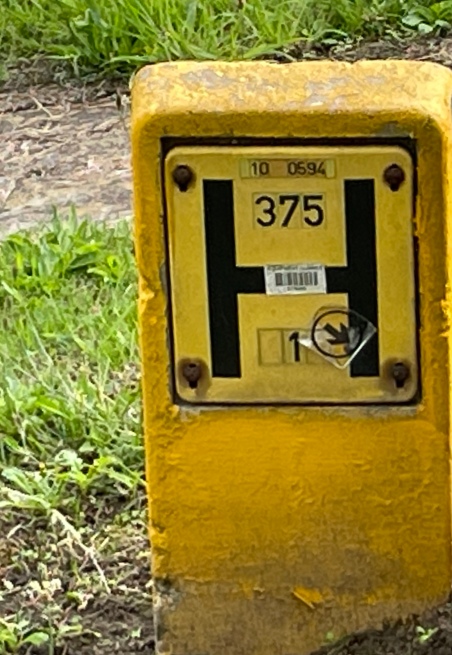
Hydrant at the entrance to Old Kirton Road.
The Digested read:
A brief account of parish governance in Trimley St Martin. Extracts from the Parish Minutes from 1925 – 1948 are included. Many of the councillors names will be familiar to those with connections to Trimley.
When it comes to imagining historic monuments a small yellow concrete slab emblazoned with a business like H is not the first thought to come to mind. To be honest, it’s unlikely anyone takes any notice of it at all but apart from being itself, namely a Hydrant, it bears witness to the unsung organisational work of the Parish Council. There are many components of our daily life we take for granted, accept as having always existing and would be greatly inconvenienced if they were not available. Over the last one hundred and twenty five years or so Parish Councils across the land have been instrumental in enabling the availability of some of these components to serve their local community.
Parish Councils are the lowest level of governance in England and cover, ’…91% of the geography of England but only 30% of the population…” but continue to represent and work for the needs of the people of their individual parishes. The rural nature of Suffolk ensures the huge majority of parishes in Suffolk are covered by Parish Councils. To take part in a parish council, either as a member of the public or a councillor, is to be part of one long historical strand, despite alterations to its role and remit of the council over the years. The two Trimley villages have separate Parish Councils, although talk of unification has taken place several times since their formation. This short article refers to St Martin’s Parish Council but the generic definitions and descriptions easily refer to both and indeed many others. Parish Councils have existed by name since 1894, following the introduction of The Local Government Act of 1894. Until then, both had individual Vestry Committees, which met independently.
The Act effectively disempowered the Church’s role in secular parish affairs and is the origin of the still extant Parochial Church Councils who now focus exclusively on ecclesiastical affairs. The nature of the boundaries and borders in the two Trimley parishes is complex and both have been a jealous of their perimeters at various times. Hence the re-siting of the historical gun in Gun Lane in the early 1980s caused indignation amongst some of the St Mary’s population as described in:
My recent research into Trimley St Martin’s Vestry Committee and Parish Council Minutes was conducted in an attempt to obtain a wider view of St Martin’s parish governance as it moved from the mid 19th century to the start of Queen Elizabeth II’s reign. Inevitably, it lead to more questions and of course, more research but it demonstrated how seemingly small actions have slowly improved the quality of our lives.
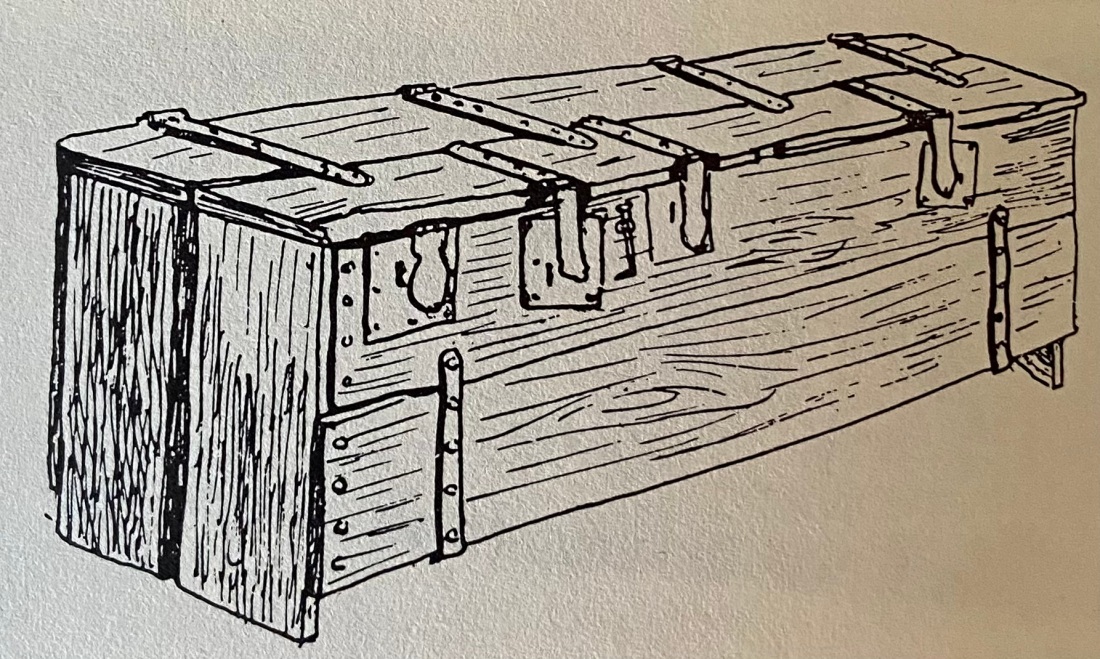
Example of a Parish Chest used to store Church documentation and those of the Vestry Committee.
In the 19th century, it was comparatively simple: the Vestry Committee was responsible for the appointment Parish Officers, which in Trimley St Martin included Constables, Surveyors, Overseers of the Poor, Sextons and Churchwardens. For several hundred years the remit was based on the secular requirement of the Parish to maintain law and order, keep the highways in good condition, manage charities and raise money for the maintenance of the Poor. During the early Victorian era many of the officers were significant farmers who were also likely to have been members of the Colneis Hundred Association and as such had considerable sway and influence over many aspects of village life. As Vestry committee members their actions could have a significant impact on villagers and upon occasion extend they extended their personal remit to their own workers as may be read in:
https://trimleystmartinrecordersblog.com/2022/12/15/winter-1838/.
Almost invariably Vestry positions were occupied by men but there are instances when where women were admitted to the Committee. So far, it would appear only two women in Trimley St. Martin served on the Vestry Committee, Namely, Mrs Rebecca Williams of Morston Hall, who was appointed on March 8th 1873 and stayed the course until her death in 1877. Before his death, her husband had been a Vestry Officer. The other was Mrs Evans.
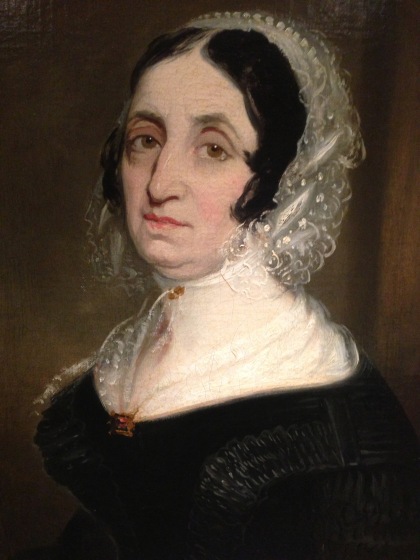
Mrs Rebecca Williams of Morston Hall. Courtesy of Spencer Williams. Not to be reproduced.
It was about eighty years before another woman became involved with parish governance, namely, Mrs V. M. Herring in 1953. and it is true to say Vestry and Parish Council officers were entirely composed of men. (Former and existing Parish Councillors Heather Rodwell and Ann Owen recall being invited to join the Council in the 1970s.) In the early days , the tight nature of the Committees meant one person was frequently responsible for several roles, which altered on a semi-regular basis. Vestry Committees deserve a whole article to themselves as they reflect a rural economy based in the village where the majority of incomers were the wealthier farmers. It was not unknown for the working classes to undertake inland migration but mainly village society was comparatively static until the railways, improved road transport systems and postal facilities changed communication and travel Alongside these improvements came the golden age of the bicycle which enabled workers to cycle to larger centres of population.
By the last decade of the 19th century there was a national perception for the need to separate the secular and ecclesiastical elements of the Vestry. It was clear the old forms of governance were no longer suitable for a changing society. Public utilities such as lighting, road maintenance, drains and refuse collection needed to be co-ordinated and conform to agreed standards. Public health and safety was increasingly important. Enter the arrival and implementation of the Local Government in 1894, which amongst other concerns saw a sea change in responsibilities and a more democratic composition of parish officers. Overnight the old Vestry Committees with their ecclesiastical base were abolished to be replaced by Parochial Church Councils, who focussed on Church matters. More importantly it saw the introduction of Parish councils who focussed on the burgeoning secular issues and requirements. The Parish Councils offered a more democratic approach to parish governance although it may be there was some cynicism about the experience of their membership. This postcard suggests the members were young puppy dogs who had much to learn.
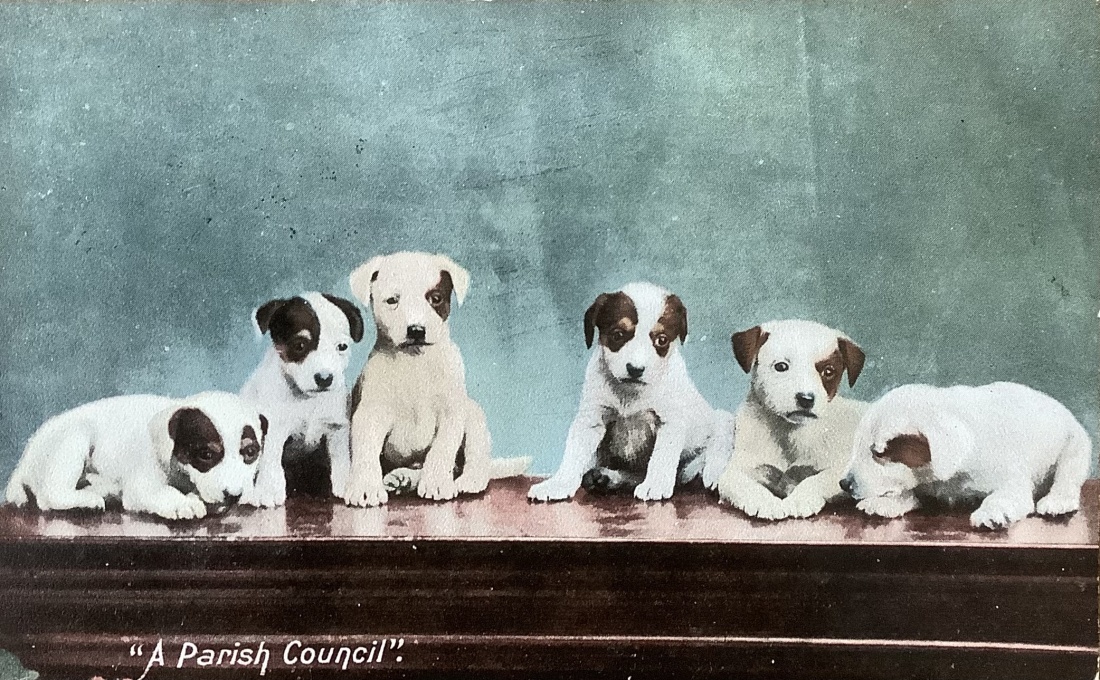
Postcard from the start of the 20th Century.
Unfortunately, the only documentation which has survived for the early period of the Parish Council is the Trimley St Martin Parish Council Declaration Book (1894 – 1919). Its existence allows us to see who was involved because in order to serve on the Council each Officer had to sign in the presence of another for validation purposes. Failure to do so meant the position was voided. Were it not for this book the Councillors names and contribution would be unknown. Anyone with longstanding village connections will immediately recognise some of the surnames in the Wordclouds below, some of which are on the Village War Memorial. We can see the officers were no longer just significant farmers but the base had widened to include local traders and shop keepers. For example, Samuel Scarfe was the Miller based in Mill Lane, William Brame was the Post Office Master/Shopkeeper, Henry Lummis was a timber merchant and Walter Giles was the local builder. The Rectors were involved but their role was voluntary and not compulsory.

Names of Trimley St Martin Parish Councillors between 1894 and 1921…
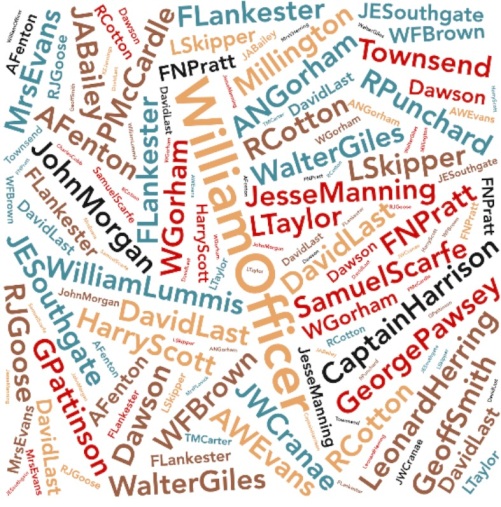
…and between 1921 and 1956
Trimley St Martin Parish Council Minutes have survived from 1921 onwards and evidence emerges of a changing and increasingly complex village community. So many small changes were undertaken , which even at the time may have been imperceptible but were important to the needs of a 20th century society. All new services or facilities were implemented with reference to either East Suffolk Council or Woodbridge Rural District Council. (Parish Councils didn’t have quite the same autonomy as the old Vestry Committees. )
I have chosen to abstract some items from the Agendas for the twenty years or so from 1930 to about 1948. This period covers the inter-war years and the immediate aftermath of the Second World War. Until 1930. The entries are drawn at random and do not cover anything like all of the areas of concern. Meetings at this time were not monthly but were held more on a quarterly basis.
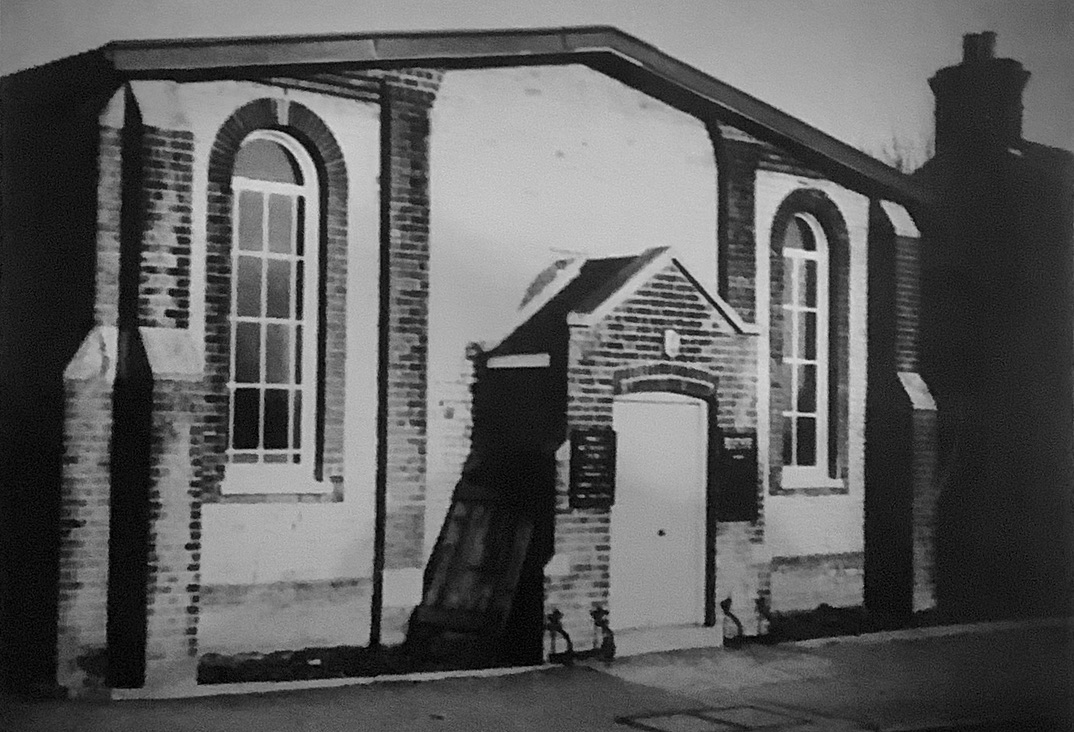
The old (Primitive) Methodist Church, which blew down in the 1987 hurricane. For many years the Primitive Methodist School Room was the meeting place for Trimley St Martin Parish Council.
In 1925 Mr William Officer was the Chairman. After that date Captain Reginald Foster Harrison of St. Martin’s Cottage in Drab’s Lane was the Chairman and oversaw the introduction of these facilities alongside his fellow Councillors. He eventually resigned in 1947, when he was replaced by Mr R.G. Cotton. Captain Harrison died in 1957, aged 77. The Clerk to the Council was Mr. (William) Norman Scarfe, son of Samuel Scarfe, the former Miller and Parish Councillor. In the event he remained in post for more than thirty years. Born in 1890, he had served in the First World War and when it ended returned to work as a Rating and Valuation Officer. He was 66 when he eventually retired from the Parish Council and was rewarded with a chair from Chandler’s furniture shop in Felixstowe. (If it came from there it would have been of good quality. ) Norman Scarfe wrote clear and concise minutes with an assured and legible hand. As Clerk his task was to record and not to influence or comment. Unlike some of Vestry Committee predecessors, there is no ambiguity in any of the entries. The minutes for his tenure in office (1925 – 1956) are peppered with local concerns and references to lack of hedge and fence maintenance abound. Reprimands and reminders about such matters were sent by the Clerk to all who offended.
During this period there was a marked rise in the introduction of public utilities and services. Some have developed over time whilst others have been refined or replaced, as outlined below:
1925 The council decided, “ to establish a Branch Rural Library in this Parish”
1926 Mr J Manning proposed, “… that owing to the number and high speed of motor cars and cycles on the Ipswich-Felixstowe Road, a tarred and curbed footpath, not less that 5 feet wide, should be constructed through part of the village for the safety and convenience of pedestrians using the Road.”
This was forwarded to East Suffolk County Council.
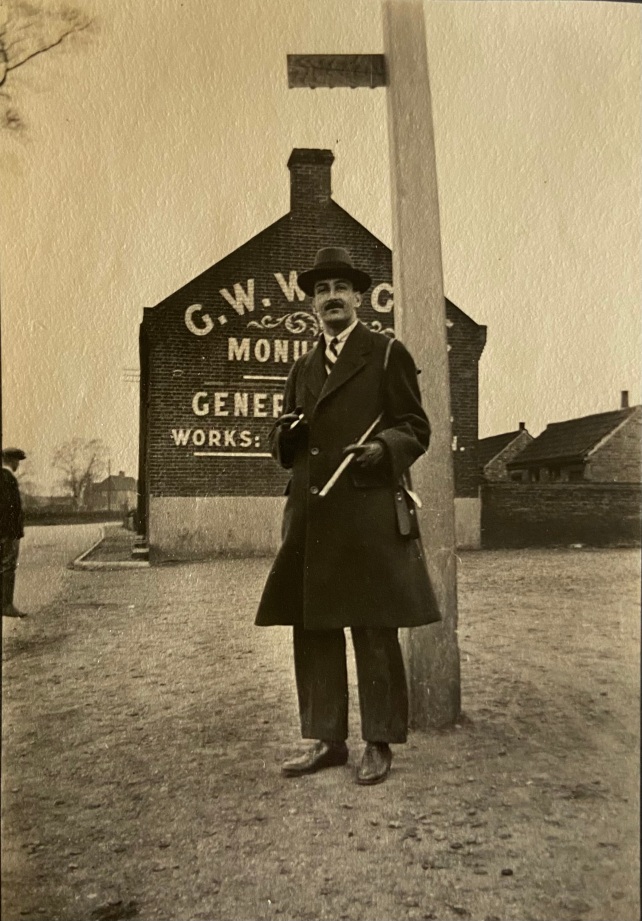
Image of ‘The Unknown Tourist’ taken outside The Hand in Hand in April 1930. The High Road looks clean and well maintained and note the neat kerbs on the pavements. The presence of a hanging signage suggests the existence of a bus service.
1927 The first and only Library report.
“The Hon. Librarian for the Parish gave and interesting report. Mr W Gorham stated that 1581 books had been issued during the year to 81 readers. The books under his charge had been changed three times during that period. This showed that the parochial Library had been much appreciated …”
The population for Trimley St Martin 1931 was 861. The figures suggest an engagement in the library by about 10% of the population.
(Although the village no longer has a static Library, in 2023 the Mobile Library service calls every four weeks on a Tuesday at Reeve Lodge, Stennett’s Close and Faulkener’s Way. )
1931 The laying of the water mains and the installation of a water hydrant at the crossroad of the High Road and Drab’s Lane at the same time. (Now known as Old Kirton Road.)
It still exists.
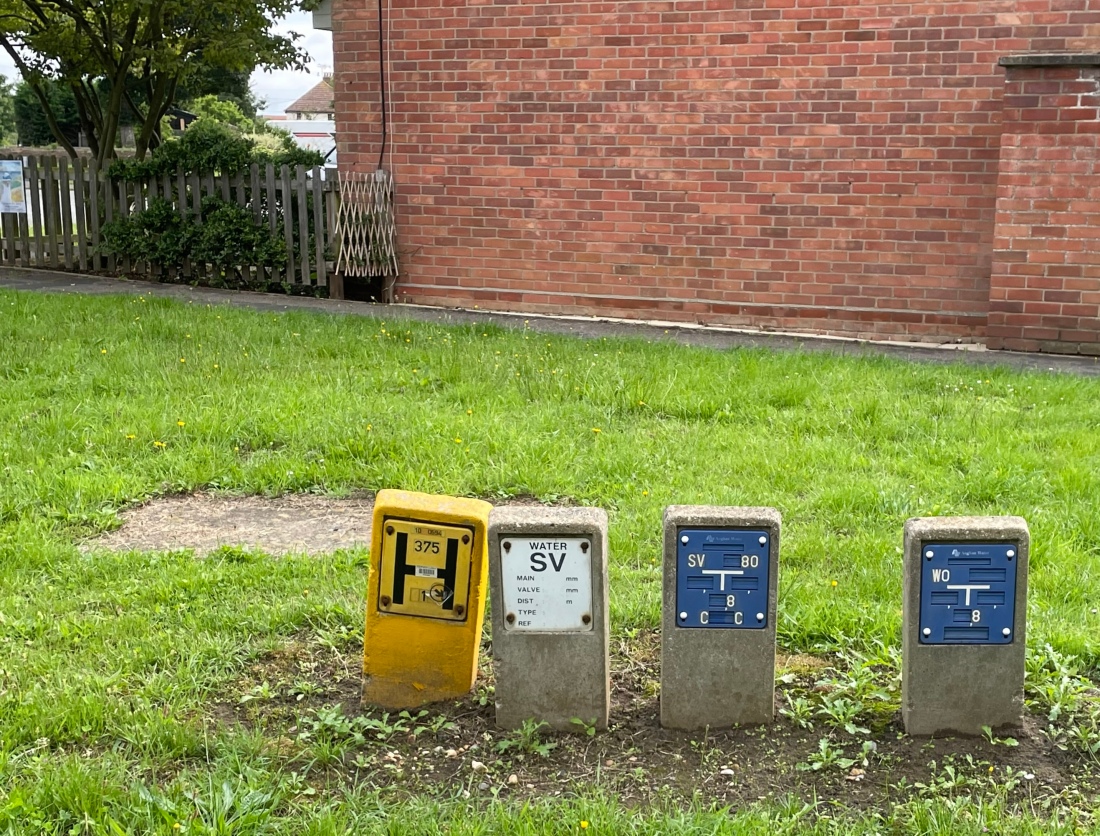
The still extant Water Hydrant on the corner of Old Kirton Road. (Although the plate has been changed.)
In the same year a 7′ by 7′ shed was erected outside ‘Mafeking’ in Drab’s Lane for use as a shop. The council investigated to see if it conformed to Bye-Laws. ‘Mafeking’ is the building next to St. Martin’s Cottage, where Captain Harrison lived.
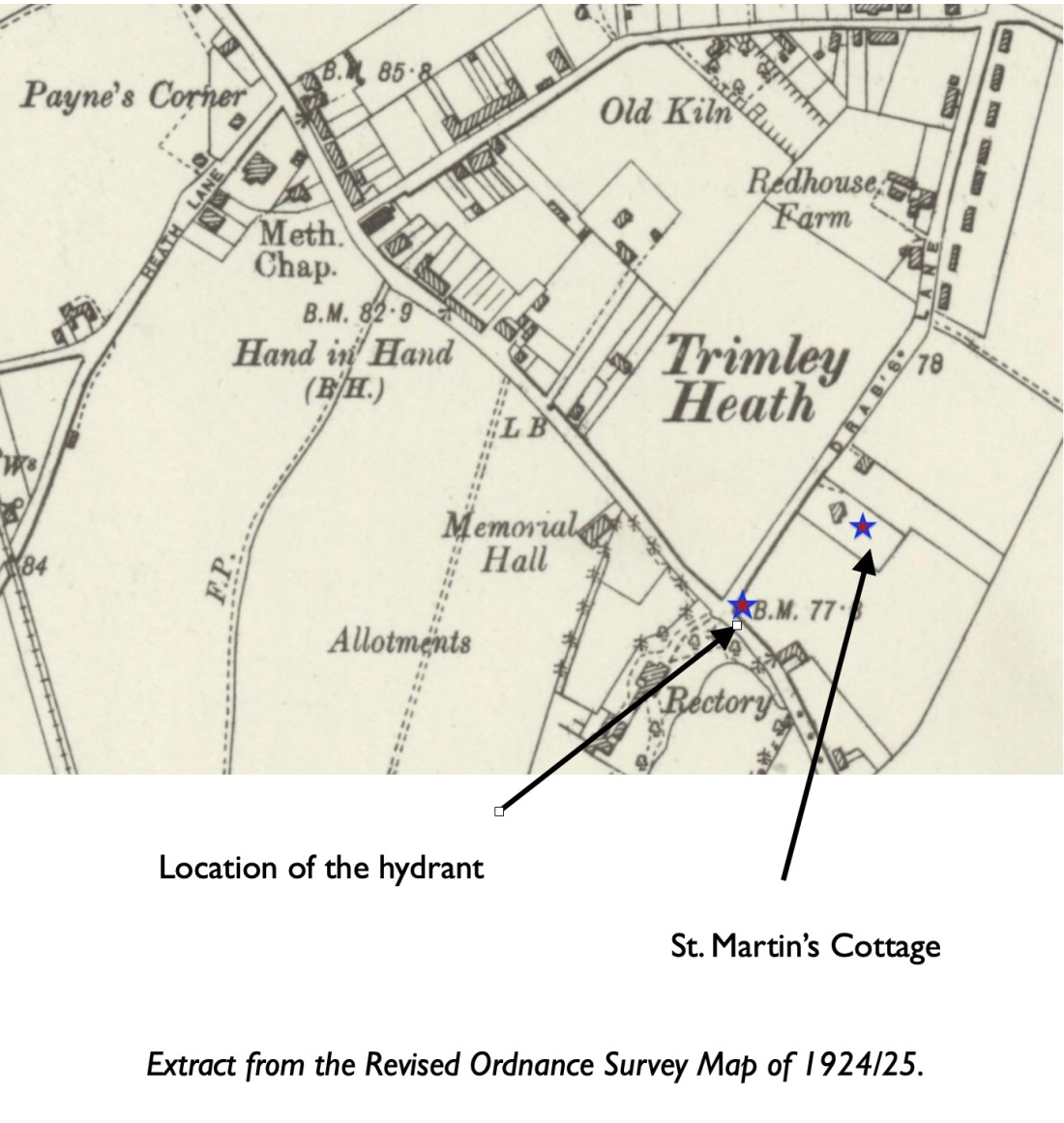
In October 1931 there was a rare intervention by the Parish Council concerning one villager’s personal circumstance. The Chairman explained the position concerning S. Mosley and he,
“…submitted a draft resolution. After considerable discussion, J. Manning proposed and H. Scott seconded that the following resolution be sent to East Suffolk County Council… ‘This Council regrets that it has been found necessary to dismiss Roadman S. Morsley. They are of the opinion that he is always so conscientious in his duties and keeps his stretch of road in such order that his dismissal is against the Ratepayers interest. This Council strongly urges that, if possible, Morsley be re-instated.’ Carried.
It was further resolved to send copies of the above resolution to Mr C C Smith and Mr J Flanders. Mr W Lummis proposed that a vote of thanks be recorded to the Chairman for his interest and work re Morley. Sec’d by J. Manning and Carried.”
No explanation is given as to why Mr Sidney Morsley had been dismissed nor whether he was re-instated. Before the war he worked as an assistant for his thatcher father but after the War he became a Roadman. My suspicion is he wasn’t because in the 1939 Register, he and his wife Gladys were living in Dawlish, Devon. The entry describes him as incapacitated. He eventually died in Devon in 1966. Was Captain Harrison’s intervention on his behalf motivated by the needs of an injured former soldier? We may never know.
1934 A sewage system was installed in the houses adjoining the Post Office. This added money to the Rates.
1936 Street lighting was installed at Payne’s Corner (now the right hand corner of Grimston Lane), Mill Lane corner and Drab’s Lane corner. It was deemed necessary as the High Road was now a built up area with a 30 M.P.H. speed limit. The national speed limit for built up areas had been introduced on 18th March 1935. Not every village greeted it with enthusiasm.
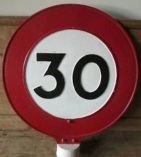
Original 1930’s Traffic sign
In the same year the Council expressed a reluctance to introduce a Scavenging scheme (Waste Collection) as it would lead to a further increase in the Rates.
1937 A possible Rates rise of 8 pennies and 3 farthings in the £ was regarded as prohibitive bearing in mind the already heavy Rate charge for sewerage. In the same year, the telephone box was installed at the High Road end of Drab’s Lane. (This was removed just before 2020.)
‘The Clerk was instructed to write to County Surveyor re the removal of dangerous bends near Kirton Road School or provision of School Warning Signs.’ Interestingly this year saw the first mention of the proposed Trimley By-Pass. The meeting resolved to inform East Suffolk County Council that it should,
“… run on the North side of the Main Road… (i.e. the High Road) …”.
The By-Pass was eventually constructed at the start of the 1970s after a vigorous local campaign.
This was also the year where it was proposed to,
“..fix a road name plates for Mill Lane near the High Road.”
Significantly by 1937 , the first intimations of the approaching war start to be anticipated. On 19th April the Clerk read details
“…of Air Raid Precautions from the Committee of the Debt R.D.C. After consideration it was resolved …to use…the Memorial Hall as a Minor Aid Post.”
At the next meeting on 29th October 1937 Captain Harrison reported on the A.R.P meeting held in Kirton Rectory.
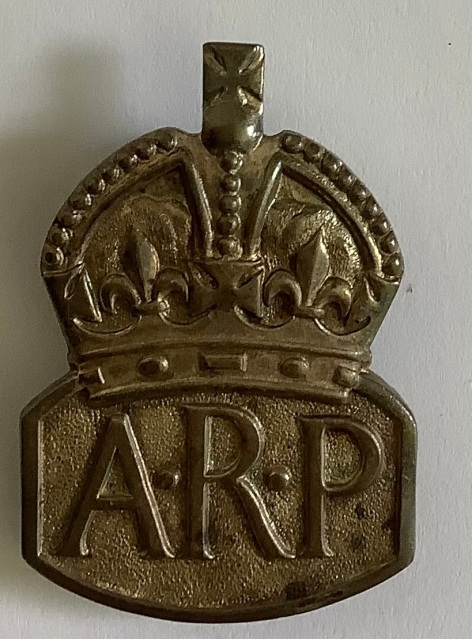
Air Raid Precautions Badge.
Property of Mr J Smith. Courtesy of Erica Entwhistle.
At the start of March 1938 Air Raid Precautions continued to be discussed. Mr Forsdike and the Rev. Weir (from Kirton) spoke about A.R.P to the meeting and,
“ … it was agreed to arrange a Lecture by Comm’der Phelp on 27th April next, at 8.p.m. in the Memorial Hall. Mr E. Felgate kindly offered to supply about 500 typed letters…”
The meeting was held but unfortunately there is no record of how many people attended. One imagines it generated much interest at the next meeting the Clerk read all the correspondence relating to A.R.P. On the 31st January 1939 further discussion of A.R.P continued and it was decided that Mr R.S. Thompson would continue as the Billeting Officer and that two extra sets of splints would be purchased.
And then, the War arrived.
In March 1940, notification from the Deben R.D.C informed the Council Elections would be postponed. The Chairman didn’t call a meeting during 1941 for economical reasons but but Messrs. Manning and Morgan stated that although there were difficulties, it was in the interests of the Ratepayers that the Council carried on. There was a marked decrease in the meetings and apart from standard concerns, the focus was on such matters as,
”…Mr Herring and his youth squad …(are) acting…as salvage stewards for this Parish.”
In 1942 the Chairman reported that,
“…the target for ‘Yanks for Tanks’ Week for this Parish had been fixed at £4,000. The forms for opening a P. O.S. Bank account were signed.”
On 20th April 1945 the Meeting discussed celebrations for V.E. Day. A public meeting in the Memorial Hut was proposed for Friday 4th May 1945.
A year later, another V.E. celebration was held with the additional intention of raising money for some school gates.
Parish business returned to normal but after seven years there was a need to provide new and improved services for the villages. Lighting was again a concern and in 1946 Public Conveniences appeared on the agenda. A letter from Kirton Parish Council proposed some be built on the corner of Drabb’s Lane. My supposition is that travellers walking home from what was then known as Bank’s Corner wished to prepare themselves for the walk home. However, in the event and,
“…after consideration it was resolved that the Clerk replies. “We do not find convenience is necessary for this Parish. “
In 1946, as services returned to normal a proposal regarding transport was made, possibly because bus services to Trimley had been curtailed during the war. E. A .Kitt proposed,
“…to ask the Traffic Commissioners to extend the Pioneer Bus Service to the Hand in Hand Inn.”
This was followed up at the next meeting with the resolution to,
“… strongly support Mr Faiers application for bus services between the Hand in Hand Inn and Felixstowe…”.
This seems rather strange because, after consulting with local transport experts Bryan Frost and Ipswich Transport Museum’s Steven Worsley, it appears Mr Faiers didn’t acquire the Pioneer Bus Company from Dawson and Gault until March 1947. According to Steven Worsley,
“…Dawson and Gault continued as Garage proprietors and in 1950 Dawson and Gould Ltd. were listed at the Pioneer Garage at Langer Road.”
From 1948 onwards, the pace picked up considerably. Mrs Herring became the Vice Chair in 1952 and in 1953, Geoff Smith of Goslings Farm became Chairman. The minutes becoming longer and increasingly complex. The next fifty years during the reign Queen Elizabeth II saw many changes and a second article will be available in the future concerning just what happened next.
Parish councils continue to represent our community interests as best they can within the constraints of contemporary legislation and the constraints of central Government requirements. It is as important now as it was in early years and centuries that local participation continues and expands.
Significantly, one of the major changes since 1948 is the complete turn around in the gender balance of the Councillors. Out of seven acting Councillors today, five are women.
Today’s Parish Council continues to monitor problems and works to have these resolved. If your are interested in becoming a Parish Councillor you can contact the Parish Clerk at:
parishclerk@trimley-st-martin.org.uk
*************************************************************************************
If you would like to contribute to the Village Recorder’s Blog or would like to see a particular subject covered, please contact:
trimleystmartinrecorder@gmail.com
LR 05/08/2023
Liz thank you for showing me this article.Very interesting.Look forward to more.
LikeLike
Thank you, Helen. Plenty more to come!
LikeLike